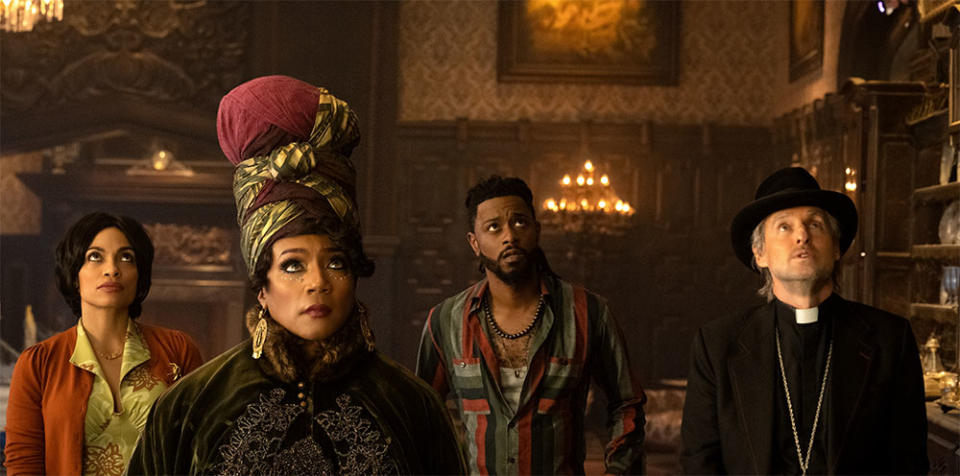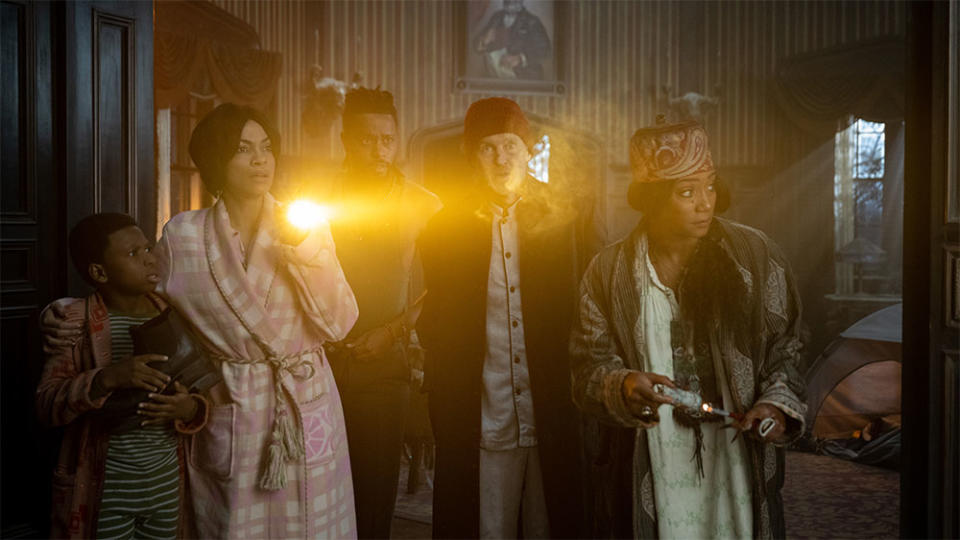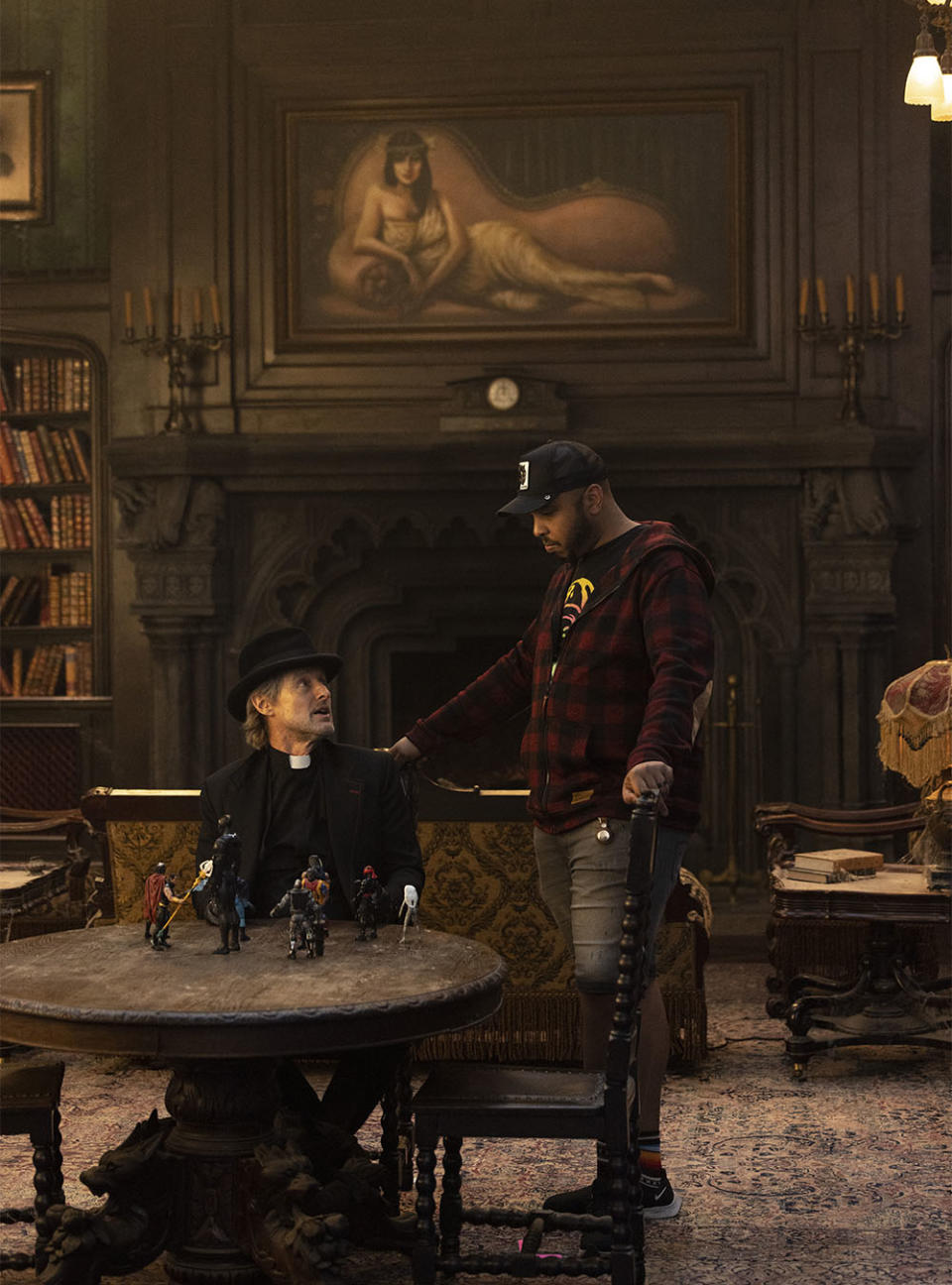‘Haunted Mansion’ Director Justin Simien on the Original Darker Ending and How Test Screenings Changed the Film
- Oops!Something went wrong.Please try again later.
- Oops!Something went wrong.Please try again later.
- Oops!Something went wrong.Please try again later.

[This story contains spoilers for Haunted Mansion.]
Haunted Mansion director Justin Simien wanted to make a Disney movie that wasn’t afraid to challenge younger audiences in the same way that the Disney classics of his youth did. From Bambi’s Mother’s death in Bambi (1942) to Scar murdering Mufasa in The Lion King (1994), Disney has never shied away from heavier subject matters and themes, but in the case of the Haunted Mansion, there was one line that Simien just could not cross.
More from The Hollywood Reporter
Box Office: 'Haunted Mansion' Spooked, 'Barbie' Scores Record $93M Second Weekend in U.S.
'Haunted Mansion': How VFX Brought Classic Ghosts to the Big Screen
Box Office Bonanza: 'Barbie' to Blast Past $700M Globally by Sunday After Record Week
The lead of Simien’s film is LaKeith Stanfield’s Ben, a former astrophysicist turned paranormal tour guide in New Orleans. Ben’s life hasn’t been the same since his wife, Alyssa (Charity Jordan), died in a car accident, and so the character was originally slated for a rather devastating ending, as opposed to the more upbeat version that’s in theaters now.
“Once we cast LaKeith, there was something that changed about what I personally needed from the ending of the movie,” Simien tells The Hollywood Reporter. “Frankly, I didn’t want to see a Black man have a tragic end in a movie like this. I wanted him to have hope at the end of the movie, and a tragic end for a Black character would’ve been really hard to swallow, at least for me right now.”
There were also versions of the movie that featured a bigger role for Alyssa’s ghost, but the late addition of a more heartening epilogue expanded on the idea of Ben potentially moving on with Rosario Dawson’s Gabbie and her son Travis (Chase Dillon), who dealt with their own recent loss.
“We shot so much movie. There’s probably a four-hour version of the movie that nobody would want to sit through, including myself,” Simien says. “It has different possibilities of what could have happened between Ben entering the house and the group finally exiting the house and deciding to come back to it on their own. But through the process of just testing it and working with the Disney team, that’s not exactly the version that we ended up with.”
Test screenings are a key step in Disney’s filmmaking process since the studio strives to make films that appeal to everyone. And while not every filmmaker is fond of testing, Simien values test audience feedback a great deal.
“It was definitely a very tricky process, especially within a very large studio, but I don’t really know how to make a movie without [testing], to be honest,” Simien shares. “I don’t want to just make things for myself to live inside a little magic box. I want to make things for people to see, and I want my work to hit people in a certain way. So, if I could, I would test all the way through. I would test screenplays, and I would even test scenes after I shot them, if that was a thing we could do.”
Below, during a recent spoiler-filled conversation with THR, Simien also discusses the head-turning moment he witnessed while riding Disneyland’s Star Wars: Rise of the Resistance attraction with Dawson.
Has Disney given you permanent line-cutting privileges for the Haunted Mansion ride? A golden ticket perhaps?
(Laughs.) Not unless there’s something I don’t know. When I finished working for [Disneyland] during college, I took this booklet that allowed me FastPass access. This was years and years ago, but to my chagrin, I found out that it no longer works. So, if they want to [provide a golden ticket], I’m there.
Did you include anything in the movie that’s considered inside baseball for you and anyone else who’s worked at Disneyland?
There are definitely a lot of Easter eggs in the movie, and a fun one that I honestly forgot that we had even put in the movie until I started seeing it again with audiences was the line partitions. You see the actual gargoyles outside of the ride as you’re queuing to get in. So there’s a moment where that’s kind of featured, but we tried to find a space for everything that truly made sense for the story.

LaKeith Stanfield has a very different energy than most leading men. Did you want that very quality, especially in a ghost story?
Yeah, we really needed somebody who was going to bring the audience into a character that’s really in grief. He’s a little rough around the edges, and he isn’t in his most charming era. What’s so remarkable about LaKeith’s past performances is that he really has his ability to bring you in through the eyes, whether you can understand what he’s saying or you disagree with him. (Laughs.) Even when he makes you angry in things like Judas and the Black Messiah, you can’t help but care for him. You want to take care of him, and that was really critical for this leading role. He’s also really charming and funny and sexy and all the things that a leading man is. It just comes in this really unique and soulful package.
Do you relate to his character the most?
I certainly do relate to that character the most. Ben [Stanfield] and Travis [Chase Dillon], and their relationship, probably has some part of my psychology expressed through it. This grizzled-over adult has had to hide his vulnerability, but is now opening up to this kid who needs a father figure. That probably has something to do with me as an adult, finding a way to take care of that inner child, who really just wants to play but needs some guidance, and maybe opening my adult self up to some vulnerability as well. I mean, that all sounds very intense for a movie like this, but that’s just the place that I work from. So that relationship really came through for me in the script as well as in the performances.
For a movie about letting go, was this movie therapeutic for you at all?
Man, I don’t know that it was, but I might need some therapy after the movie. In fact, I’ve already scheduled my sessions. (Laughs.) But it was definitely exciting to play in a much bigger sandbox, and to feel unrestrained by budget and time to realize some more ambitious things. Maybe it was a little cathartic getting to tell such an emotional story on such a big scale.
So you had a very tricky task in this movie, as you had to have Ben grieve his loss, while Gabbie (Rosario Dawson) and Travis grieved their own loss. But you also had to open the door to a new family potentially being formed, without going too far until their losses are fully processed. Was this quite a balancing act?
Yeah, it was a balancing act. It’s certainly difficult to tell a story about grief in the packaging of a large, four-quadrant, family-style movie, but at the same time, so many of the movies that Katie Dippold, the screenwriter, and I were inspired by managed to do that. Certainly some classic Disney movies managed to do that, and I think the Haunted Mansion ride really manages to do that as well. What’s core and essential to classic Disney is the sense that life is really difficult and that kids are aware of that. There’s some scary and dark things going on in the world around them, but [classic Disney movies] also give them some strength, some courage and the feeling that they will find family and get through it and even laugh a little bit. Those are the ones that stick to our bones, so it’s certainly a tough balancing act, but it felt like the right way to go on this one.

The egg-pun scene and the action figure scene did a nice job setting up the potential for a new family between Ben, Gabbie and Travis.
You see a guy in Ben who really doesn’t want to open himself up again. There’s this quote about grief, and I don’t remember exactly who said it, but it talks about the mistake people make when they’re going through a grieving process. People say, “I’m never going to open myself up again to love. I’m just going to hold really tight and build a statue around the parts of me that feel really vulnerable,” and I think that’s where LaKeith’s character is at the top of the movie. So he slowly learns to open up and realizes that the key to getting through his grief is to just move through it and to look forward to something new on the other side. Again, it’s really heavy messaging, and we tried to background it a bit.
The egg scene was such a joy to shoot between LaKeith and Rosario, and you feel the chemistry between Ben and Gabbie and Travis, this potential new family unit. Even with the uncles and aunties like Danny DeVito, Owen Wilson and Tiffany Haddish, I certainly root for them all as a family unit by the end of the movie. We want them to all move into that house somehow and make it work between who they are now and all these crazy ghosts. So that certainly was thematically important point to drive home here.
Maybe it’s because of Ghosbusters: Afterlife, but I kept expecting Ghost Alyssa to appear in dramatic fashion for a tearful goodbye with Ben. While I prefer the choice you made, were you ever remotely close to doing that?
Pretty close. You kind of see some remnants of it. There’s a dream sequence where, for a moment, we see Ben follow her through the house. I actually really felt strongly that what wakes Ben up again inside of the house is the potential to find her with his camera. He’s presumably been using it to find her, unsuccessfully, so that remains as a bit of subtext in this version of the movie. But there certainly were some more overt searching-for-Alyssa scenes and ideas in different forms of the movie. We shot so much movie. (Laughs.) There’s probably a four-hour version of the movie that nobody would want to sit through, including myself. It has different possibilities of what could have happened between Ben entering the house and the group finally exiting the house and deciding to come back to it on their own. But through the process of just testing it and working with the Disney team, that’s not exactly the version that we ended up with.
The epilogue then allowed you to hint even more at a possible future for Ben, Gabbie and Travis. Was that a late addition?
The epilogue was certainly a late addition. The first version of the movie that I encountered had a bit of a darker ending, one that I actually really respected and enjoyed, but I correctly guessed that it maybe wouldn’t get past the sort of Disney machine. But once we cast LaKeith, there was something that changed about what I personally needed from the ending of the movie. Frankly, I didn’t want to see a Black man have a tragic end in a movie like this. I wanted him to have hope at the end of the movie, and a tragic end for a Black character would’ve been really hard to swallow, at least for me right now. So we went with something a bit more hopeful, but there was probably something to the other version as well.
You touched on it moments ago, but what did you make of this particular test screening process?
I love the test screening process. Dear White People, my first feature, went through a lot of test screenings, and that was a difficult movie to test screen within the studio system once we got picked up. And I actually really wanted to incorporate some of that feedback, but I didn’t get a chance to on that movie. So, with my second movie, Bad Hair, we had almost endless test screenings that the producers and I went through on our own, particularly between the Sundance debut and its eventual release on Hulu.
And now, with Haunted Mansion, there were also a lot of test screenings. It’s tricky in a studio environment, and the thing about test screenings is that you can get really emotional about the reactions. You can get very emo and caught up and defensive, and I don’t think that that’s really the best way to go about it. Audiences always tell you the truth. They may not articulate it perfectly, and they may not actually point to the correct solutions to everything, but you need people to tell you where the movie is meeting them. It takes so long to make a movie, and it’s almost impossible to see the forest for the trees. So you need that.
The movie that we all remember way after its release and its initial buzz and conversation is co-created between the movie itself and audiences. So you’re flying blind if you don’t go through the [test screening] process. What was interesting about having multiple test screenings in the studio environment is that you have to manage not only your own emotional defenses to what people are saying, but you have to manage a lot of other people’s emotional defenses to what people are saying, as well. It’s a very fast-paced environment, and you have to find the truth of what people are saying. Maybe it’s not literally what they’re saying, but it’s what they call “the note behind the note.”
So it was definitely a very tricky process, especially within a very large studio, but I don’t really know how to make a movie without it, to be honest. I don’t want to just make things for myself to live inside a little magic box. I want to make things for people to see, and I want my work to hit people in a certain way. So, if I could, I would test all the way through. I would test screenplays, and I would even test scenes after I shot them, if that was a thing we could do.
Did Winona Ryder wander onto set from a neighboring soundstage? Is that how she ended up in this movie, uncredited?
(Laughs.) We kidnapped her. We told her that she was shooting Beetlejuice 2, and she just went with it for a while until she caught on. No, she was one someone that we wanted from the outset. Carmen Cuba, the casting director, myself and the studio were really enamored with this idea of plugging in classic faces in these cameo roles, and it just felt so right that she’d be the tour guide at the end of the movie. She was just so delightfully weird and funny in her performance, and it was a super magical time having her on this project. We were shooting for quite a while, so she had time to rest up and regroup [from Stranger Things 4] and then join us. [Writer’s Note: Stranger Things 4 wrapped production in the Atlanta area shortly before Haunted Mansion’s own Atlanta shoot started.]
Rosario Dawson told me the story of how she serenaded Danny DeVito in a Stormtrooper costume, so did you have your own run-in with Rosario the Stormtrooper?
My run-in was also seeing her serenade Danny, and it was beautiful. But my favorite Rosario-Star Wars moment was when I was riding Star Wars: Rise of the Resistance at Disneyland. There’s a moment where you’re arrested by the Empire, and you walk through a corridor with all these straight-faced Stormtroopers and guards that are glaring at you because you’re a prisoner. And these castmembers are wonderful, however, I was with Rosario Dawson, who’s Ahsoka. And the moment she passed their eye line, you could see them just geek out a little bit. So that was probably the most adorable thing I’d ever seen because they truly were in awe of her, and I don’t think there’s anyone more deserving than her to be the Queen of Star Wars at this time.

And lastly, have you had any haunted experiences?
I wouldn’t call them hauntings, but I’ve certainly had moments that felt a little bit larger than reality. One of the reasons why the movie touches me so much is that I really have gone through some loss from a really young age. I lost a best friend after high school, and with a few exceptions, when I’ve lost people, whether it was my grandmother or some of my aunts and uncles, there tends to be this moment afterwards. In the script, Katie Dippold came up with this phrase for it called “ghost winks,” and I’ve never quite heard it put that way before. So I’ve had quite a few ghost winks in my life and moments that I really can’t explain in any other way. I can be a bit cynical. It takes a lot for me to really believe in something supernatural, and yet these things would happen that I just couldn’t describe or relate to in any other way. So that opened me up to this sense that they were still here, somehow, and those have been moments of great comfort rather than fear.
***
Haunted Mansion is now in theaters. This interview was edited for length and clarity.
Best of The Hollywood Reporter

